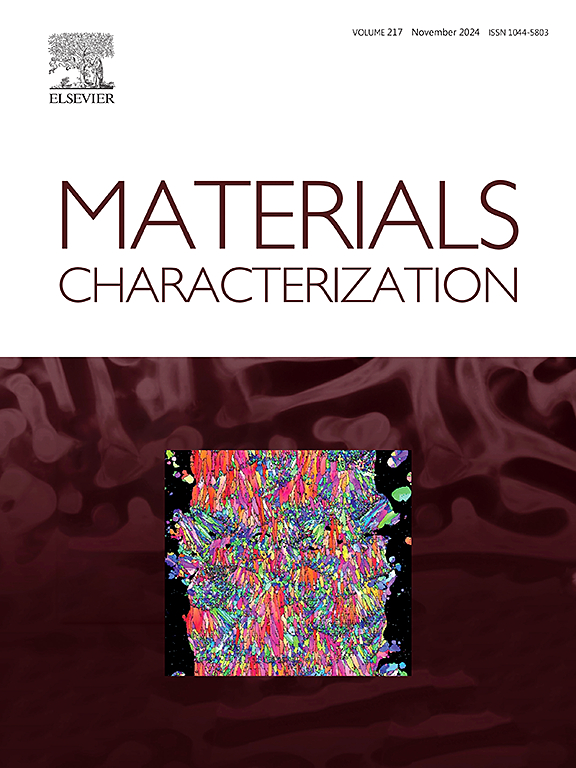Effect of solution temperature on microstructure and mechanical properties of wire arc additive manufactured maraging steel
IF 4.8
2区 材料科学
Q1 MATERIALS SCIENCE, CHARACTERIZATION & TESTING
引用次数: 0
Abstract
Solution and aging heat treatment (SAT) is an effective method for enhancing the mechanical properties of maraging steel. The solution temperature is a key factor affecting the SAT; however, there is a lack of research on the effect of solution temperature on the organizational properties of wire arc additive manufacturing (WAAM) maraging steel. In this study, thin-walled structures of maraging steel were prepared using WAAM. The microstructures and mechanical properties of the As-deposited (AD) and SAT specimens subjected to varying solution temperatures were systematically analyzed and compared. The AD specimen exhibited obvious segregation behavior of Ti, Mo, and other alloying elements and an anisotropic microstructure and mechanical properties. Following the SAT, the strength of the maraging steel significantly increases due to the generation of nano-precipitated phase. The ultimate tensile strength (UTS) of the AD specimen is 1282.5 MPa, and that of the 900 °C SAT specimen is 1530.8 MPa. At higher solution temperatures, the element distribution is more homogeneous, and the nano-precipitated phases are finer, resulting in a higher strength. The UTS of the 1000 °C SAT specimen increases to 1732.7 MPa. However, at a solution temperature of 1100 °C, the UTS decreases to 1634.1 MPa because of the increase in the grain size and prior austenite grain size. It has been shown that a reasonable solution temperature can attenuate elemental segregation precipitation and promote the generation of a nano-precipitation phase to enhance the performance of the maraging steel without excessively coarsening the grain.

固溶温度对丝弧添加剂制备马氏体时效钢组织和力学性能的影响
固溶时效热处理(SAT)是提高马氏体时效钢力学性能的有效方法。溶液温度是影响SAT的关键因素;然而,关于溶液温度对电弧增材制造(WAAM)马氏体时效钢组织性能影响的研究还比较缺乏。本研究采用WAAM制备了马氏体时效钢的薄壁结构。系统地分析和比较了不同温度下as沉积(AD)和SAT试样的显微组织和力学性能。AD试样表现出明显的Ti、Mo等合金元素偏析行为,具有各向异性的显微组织和力学性能。经过SAT处理后,由于纳米析出相的产生,马氏体时效钢的强度显著提高。AD试样的极限抗拉强度(UTS)为1282.5 MPa, 900℃SAT试样的极限抗拉强度为1530.8 MPa。在较高的固溶温度下,元素分布更均匀,纳米析出相更细,强度更高。1000℃SAT试样的UTS增大到1732.7 MPa。而在1100℃的固溶温度下,由于晶粒尺寸的增大和奥氏体晶粒尺寸的增大,UTS减小到1634.1 MPa。结果表明,合理的固溶温度可以减弱元素偏析析出,促进纳米析出相的生成,在不使晶粒过度粗化的情况下提高马氏体时效钢的性能。
本文章由计算机程序翻译,如有差异,请以英文原文为准。
求助全文
约1分钟内获得全文
求助全文
来源期刊

Materials Characterization
工程技术-材料科学:表征与测试
CiteScore
7.60
自引率
8.50%
发文量
746
审稿时长
36 days
期刊介绍:
Materials Characterization features original articles and state-of-the-art reviews on theoretical and practical aspects of the structure and behaviour of materials.
The Journal focuses on all characterization techniques, including all forms of microscopy (light, electron, acoustic, etc.,) and analysis (especially microanalysis and surface analytical techniques). Developments in both this wide range of techniques and their application to the quantification of the microstructure of materials are essential facets of the Journal.
The Journal provides the Materials Scientist/Engineer with up-to-date information on many types of materials with an underlying theme of explaining the behavior of materials using novel approaches. Materials covered by the journal include:
Metals & Alloys
Ceramics
Nanomaterials
Biomedical materials
Optical materials
Composites
Natural Materials.
 求助内容:
求助内容: 应助结果提醒方式:
应助结果提醒方式:


